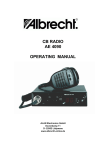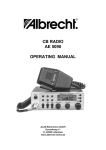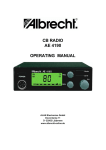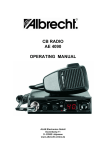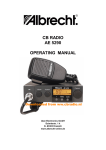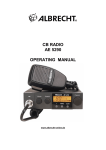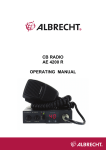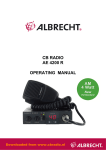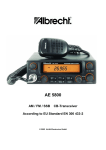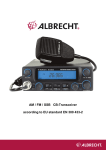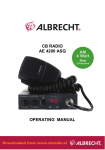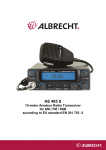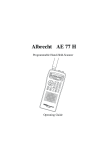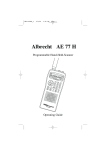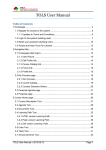Download CB RADIO AE 5290 OPERATING MANUAL - Alan
Transcript
CB RADIO AE 5290 OPERATING MANUAL ALAN Electronics GmbH Dovenkamp 11 D- 22952 Lütjensee www.albrecht-online.de 2 Index Important note Introduction Accessories included Safety Precautions Front view LC Display Rear view Country switch setting before Installation Installation of the radio Power supply Antenna connection Operation Before switching on Switching on and adjusting volume Selecting the operating channel Field intensity meter (S-meter) Adjusting squelch (muting) AM / FM mode switch Special interest channels MEMO modus Channel scan Channel scan among stored stations Transmitting and correct use of microphone External sockets External loudspeaker External S-meter Microphone socket Service and Warranty informations Legal Information Albrecht Radio Passport Declaration of Conformity Technical Details Service contacts 3 3 4 4 5 5 5 6 7 7 9 9 9 9 9 9 10 10 10 11 12 13 13 13 13 13 13 14 15 15 16 17 17 3 Important Note Your Albrecht AE 5290 corresponds to the latest European CB standards. As a unique feature, it has a country switch which allows selecting the operation mode according to the country, where You intend to use the radio. Please make sure that You put the country switch on the back side of the radio into the correct position before installing and connecting the power supply! 40 FM 40 channels FM / 4 Watt (former “CEPT” settings with 40 Channels FM according to EN 300 135-2). This mode can be used in nearly all European countries (in some countries, individual licences are still requested even for 40 CH FM. For details see the latest issue of our “Radio Passport”). 80/12 80 channels FM / 4 Watt, 12 channels AM / 1 Watt. You need a licence to operate the radio in Germany in this mode, and in certain border regions transmitting on channels 41 to 80 in FM is not allowed. 40/40 40 channels FM / 4 Watt, 40 channels AM / 1 Watt. Latest European Standard EN 300 433-2, not yet applied in all countries. In Belgium, France, Germany, Italy, Portugal, Spain and Switzerland You need a licence to operate the radio, while it is already free of charges and licence in Finnland and Netherlands. Introduction Your new Albrecht CB Radio AE 5290, developed and manufactured in accordance with the latest CB regulations, offers you: • 40 channels FM / 4 watt or • 80 channels FM / 4 watt / 12 channels AM / 1 Watt or • 40 channels FM / 4 Watts / 40 channels AM / 1 Watt • Channel selection knob on the radio set and UP/DOWN buttons on the microphone • Channel scan up and down the frequencies • 5 freely programmable memory positions for stored stations • Multifunction LCD display • 6-pole microphone socket, suitable for amplifier microphones, selective calling systems or Packet Radio modems/TNC’s • Socket for external S-meter • Socket for external loudspeaker 4 Please read this operating manual through carefully. This will enable you to make use of all the functions your new CB Radio has to offer as soon as possible. Accessories included Your AE 5290 comes operational with the following accessories: • mobile mount • 2 knurled screws for the mobile mount • 2 rubber washers for the mobile mount • DC plug-in power cable with looped-in fuses • 2 spare fuses • Electret hand-held microphone with pre-amplifier and UP/DOWN buttons • microphone hanger • various screws to fasten the radio and microphone fixing devices • User manual with circuit diagram and Radio Passport Safety Precautions People with pacemakers are recommended as a precaution to consult their doctor before operating the CB radio. Not all types of pacemakers are sufficiently protected from radiation from a nearby transmitter, so do not assume it is safe to start operation without checking! Please remember that you are in the immediate vicinity of a transmitting aerial, particularly when used as a mobile. If your doctor, or the manufacturer of the pacemaker, has recommended keeping a certain safe distance from the aerial, then please follow their instructions! Do not transmit without connecting the aerial and never touch the aerial during transmission! Please also take road safety into account! CB Radio (even when only receiving, particularly when volume is turned up) can divert your attention from the road! Road safety is of course to be given priority! Therefore only use your ALBRECHT AE 5290 when the traffic situation enables it to be used safely. 5 Front view ReceiveVolume Squelch Channel switch ON / OFF Memo-channels AM-FM-switch Scan-switch LC Display FM-Mode Memory Location Memory Mode Channel S/PWR Meter Rear view Brand plate with country list Country switch in 40FM position Socket for external S-meter Antenna socket 50 Ohms PL-259 Standard External speaker 8 Ohms, min. 2 W DC power cable socket 13.2 V 6 Country switch setting before installation Before You install Your new CB radio, You should preset the country switch on the rear side of the radio according to the local authority requirements. If You should not need any licence in Your home or guest country, You should use the factory default setting of the switch: This is the left position on the picture, 40 FM. Please consult our Radio Passport (see the chapter “Legal Issues” later in this manual) 40 FM This is former “CEPT” mode, the position which is allowed in most countries. Here the radio works on the international 40 Channels in FM mode. The Function switch F on the front side is disabled in this mode. (Caution: In some countries You need a licence, even for this mode!) 40/40 This medium position can be used in those countries, where already all 40 international channels are allowed to be used in AM and FM. AM was traditionally used by CB from the beginning in the early 60’s in USA, and it is still the preferred mode of all truck drivers in the world. Please use this mode only in countries according to the list in the Radio Passport, and please apply for an individual licence where requested. 80/12 This position (right side on the photo) is only allowed to be used in Germany, and an individual licence is necessary. Restrictions are still in force in the border regions to other countries (except to Czechia), where transmitting on channels 41 – 80 is not allowed or only with a special licence. Re-Programming to another country code This is possible at any time, but You must • disconnect the radio completely from power supply (pull the DC cable!) • wait about 10 seconds • switch to the new position • connect the radio again to power supply. Note: never shift the country switch to another position while the radio is in use or connected to a power supply. Malfunctions may result! 7 Installation of the radio You can either operate your ALBRECHT AE 5290 in the car or at home as a base station. For installation as a mobile station in the car, a mobile mount device is enclosed. Mount the set in such a way that it is not exposed to direct sunlight if possible, as this would lead to an increase in the temperature and can decrease the (set’s) working life. The set should also not be installed near a heater. Mount the set in such a way that it is exposed to as little vibration as possible. The mobile fixing device should be attached to the dashboard, the tunnel slot or to any other suitable place using the enclosed tapping screws. Do not install the set in a place where it could cause injuries in the case of an accident (be particulary careful to ensure free leg movement). Take care not to damage any underlying wires during installation! Then insert the radio into the fixing device. Secure the set with the large knurled screws (using the enclosed plastic washers) firmly at the required angle. Also mount the microphone fixing device using the enclosed screws in an easilyaccessible place. In order to prevent interference to the vehicle electronics from transmission in the vehicle, please make sure to take any mounting instructions from the vehicle manufacturer for radios and antennas into account. Power supply Your AE 5290 receives power from the 3 pin plug-in cable. The red and black wires in the cable are for the power supply, the orange one can be used for permanent plus if required, to maintain the 5 stored stations and the last channel memory. The cable has looped-in fuses. You can choose from various methods when connecting to the power supply (red and black): Example 1 The channel last tuned into and the 5 stored stations should be maintained after switching off; the set should be able to be switched on and off at any time using the volume / on/off switch. Connect up the red and the orange-coloured wires together to the positive pole on the vehicle battery (or elsewhere in the vehicle’s electrical system with permanent plus) or to a 12 volt power unit. Connect up the black wire to the negative pole on the vehicle battery or the power unit or to a well-conductive part of the car body. Example 2 The set should be automatically switched on and off with the ignition. All stored stations should be kept in memory. 8 Attach the red wire to a part of the vehicle electrical system which is interconnected to the ignition. Connect the orange wire to a part of the vehicle electrical system which has permanent plus (e.g. the positive pole on the battery). Example 3 The set should be automatically switched on with the ignition, but should tune into the international call and emergency channel. Connect the red wire with the ignition as in Example 2, and the black wire to the negative pole on the battery or the vehicle body. Do not connect the orange wire. The end of the wire should be insulated using insulating tape. Note for all connecting methods: For EMC reasons, the cable used to connect to the power supply should be no longer than 3 metres. If you wish to operate your set at home from the mains supply then please only use a stabilized power pack with at least 2 amps permanent current-carrying capacity. Under no circumstances should you use a car battery charger, as these are not stabilized and during open circuit reach such high voltage levels that your radio set could be destroyed. In any case, please set the country switch on the rear side to the correct country position before You plug in the DC cable! Do not change country switch position while radio is still connected to power supply. If in base station use it is important to you that the stored stations are kept even after switching off and on again, then please do not switch the external power supply power unit off when you switch your set off for a short time. Only use the on/off switch on the set itself. Never repair a blown fuse with silver paper or with alumunium foil! If the fuses keep blowing, then please give your radio set to your servicing dealer to be repaired or hand it in to Albrecht’s service station. The maximum allowed voltage variation for this radio is up to 15.6 volts. Never exceed this voltage under no circumstances! The transmitting stages for your AE 5290 are electronically stabilized, and therefore it is impossible to increase output by means of excessive supply voltage. Such attempts may lead to serious damage to the radio set but will never increase output power! 9 Antenna connection Connect your CB antenna to the ANT socket on the rear side of your ALBRECHT AE 5290. Most CB antennas must be tuned to best radiation during installation to give highest effective communication range. CB specialists do that job with a standing wave meter to check and adjust the aerial. Tune the aerial to the best standing wave ratio (SWR) on an intermediate channel e.g. using Channel 1 in 80/12 mode (26.965 MHz) or Channel 20 in all other modes. On this channel you should attain a SWR of approx. 1.5 or less. If the SWR deteriorates on the highest (Channel 40) and lowest (Channel 41) channels up to a value of 2.5, then your aerial is still acceptable. SWR above 3 is too bad for good communication range. A bad SWR may also indicate that there is perhaps an installation error or missing ground. Problems may be caused through missing ground, especially in boats and motor homes with fiber glass body. For these cases, Albrecht offers a special connecting cable with matching box as “artificial ground” (AKM 27) Some antennas, like “Gamma II” are broadbanded and do not need any retuning during installations. Even if your AE 5290 has a particularly robust transmitter highlevel stage which can even withstand mismatching of SWR=3, you should still never transmit without an antenna! Operation Before switching on • Turn SQUELCH control left as far as possible Switching on and adjusting volume The on/off switch is combined in the VOLUME control. To switch on: • Turn VOLUME control from OFF position slightly right. LC display and buttons are illuminated. Then turn further until desired volume is reached. Selecting the operating channel On the radio set: • With the channel knob You can continuously select channels. The present channel is displayed. On the microphone: • Press the ∧ or ∨ button on the microphone briefly, to switch up or down a channel. • Press the respective button longer to run up or down through the channels. The present channel is displayed. Field intensity meter (S-meter) On the graded bar display You can see approximately how strong the receiving signal is. 10 The scale under the bar display (S1 to +30) helps with orientation for an input signal in the stages S1 to S9+30dB. Please note: the field intensity meter only registers a signal when the muting control has opened. Adjusting squelch (muting) Particularly in FM, noise can be a nuisance on a free channel. With the muting control (SQUELCH) You can suppress this noise - but also signals which are too weak to be received properly. This is how to adjust the signal strength required to switch on the loudspeaker, using the SQUELCH control knob: The further the control knob is turned to the right, the stronger a signal has to be in order to be audible through the loudspeaker. In order to adjust the set to be the most sensitive to incoming signals, switch to a free channel: • Use the rotary switch or the microphone buttons to find a free channel, where no signal is displayed. • Then turn the SQUELCH control carefully to the right until the noise just about disappears. Now the loudspeaker stays off when on a free channel but it switches back on when receiving even very faint signals. The muting adjustment is particularly important during channel scanning. In this mode the point to which the set is adjusted decides whether scanning is stopped at the signal or not. Therefore you should test the various muting settings for various signal strengths and get to know this function. AM / FM mode switch In the two programming modes 40/40 and 80/12, FM modulation is available on all channels, but AM only on channels depending on country switch position. AM modulation is available on all 40 channels in 40/40 or only on 12 channels (CH 4 to 15) in 80/12 mode. On these channels you can switch between AM and FM using the function button F. The display shows either AM or FM accordingly. When you switch on the set the first time it operates on FM. Please note that in 80/12 mode, on channels 1-3 and 16-80 it is not possible to operate on AM. If your radio is set to AM and you choose an FM channel, the radio will automatically switch from AM to FM. This is indicated by the FM symbol on the display starting to blink. If you switch back to a channel permissible on AM, the radio will switch back to AM. Special interest channels There are a few channels which have established themselves for certain purposes: Channel 1 Call channel on FM 11 Channel 9 Channel 16 Channel 19 Channel 24/25 Call and emergency channel, also Trucker channel on AM in Germany Water sport channel Trucker channel on AM in France, Spain and Italy Data transfer (Packet Radio, Germany only) Some recommendations are being worked out by the CB clubs for the new channels 41 to 80 in Germany. To find out which channels are suitable for special purposes, please get in touch with the respective groups or check in CB magazines. MEMO Modus Using the MEMO button You can switch at any time from the present channel (normal channel modus) to the 5 programmable stored stations (MEMO modus) and switch back again. Recall stored stations • • • After briefly pressing the MEMO button, the number of the memory position will appear with the appropriate channel. Now you can programme these 5 stored numbers using either the rotary knob or the ∧ ∨ buttons on the microphone. If you briefly press the MEMO button again the set switches back to normal modus: the stored number disappears from the display and you again will be able to see the number of the channel last used. The manufacturer has pre-programmed your AE 5290 for some commonly-used channels: • • Channel 1 Channel 9 recommended call channel on FM international emergency and call channel In Germany particularly this AM channel is also used by all truck drivers. This means: a large number of stations are listening in. If the worst comes to the worst (e.g. in case of accident etc.) there is a good chance that someone will be listening. To call other stations, who you know are listening in on channel 9, you can also use this channel. Call up the desired station on channel 9. As soon as contact has been made, agree on a free channel for your conversation and then channel 9 will be free again for other calls. An emergency channel can of course only work if as many stations as possible are listening in. Therefore listen in to this channel as often as possible; the MEMO button will help you. • Channel 19: Trucker channel in France, Spain and Italy. • Channel 4: • Channel 40 recommended call channel on AM in Germany 12 Programming Memo locations You can re-programme each of the 5 numbers of the memory positions to any desired channel (e.g. private channels or club channels): • Choose when in normal modus the desired channel and the waveband AM or FM. • Press the MEMO button (for around 2 seconds) until a memory position number (1 to 5) appears next to the channel number and ME appears on the display. • Using the channel switch choose the desired memory position number (1 to 5). • Briefly press the MEMO button to save the number.To return to normal modus turn the channel switch once, or one of the channel selection buttons on the microphone. Now the station is saved and will be stored as long as the power supply is not interrupted. Only during short power supply failures the stored numbers are kept if you switch the set off before disconnecting the power supply. Channel scan Your AE 5290 has an automatic channel scan, which can be used for all channels and for the stored numbers. First choose the mode of operation (normal channel modus or MEMO modus). Adjust the muting control to the point at which the receiver should open (see also ‘Adjusting squelch’). Start channel scan • Briefly press the button SCAN. • SCAN appears on the display and the channel scan starts almost immediately by scanning all the channels down the frequencies. • The scan is stopped at each signal worth receiving and you can listen in to the conversation. If you leave the set alone it will re-start the scan after about 5 seconds and continue to search for channels in use. Stop channel scan • You can stop the scan at any time by pressing the SCAN button a second time. • Pressing the transmission button will also automatically stop the scan modus. Change direction of scan As a special function of the AE 5290 you can also change the direction in which scanning takes place: • Press the ∨ button on microphone during the scan or turn the rotary knob slightly to the left: the scan direction will change, i.e. from higher to lower channel numbers. 13 Channel scan among stored stations • Switch your set to MEMO modus by pressing the MEMO button. • Press the SCAN button - the channel scan is now done among the 5 numbers of the stored memory positions. Transmitting and correct use of microphone With the transmission button (Push To Talk) on the side of the microphone you can switch between receiving and transmitting: • Press PTT button to transmit. The display shows TX . • Release PTT button again to switch back to receiving. When the transmission PTT button is depressed, you can speak from a distance of about 5-10 cm into the microphone. The modulation amplifier of your AE 5290 is sensitive enough and enables you in most cases to speak with even more distance, depending on how loud your voice is. An automatic regulator ensures that your partner always hears your signal at the same volume. It is best to test the best distance from the microphone for yourself with the help of another station. External sockets External loudspeaker Depending on the surrounding noise, it can be advisable to hook up an external loudspeaker. Usual commercial radio loudspeakers with 4-8 ohms impedance and 24 W minimum output can be plugged in. The cable can be up to 3 metres long. For car loudspeakers, make sure to use a two-pin 3.5 mm jack plug and ensure that none of the loudspeaker connections are attached to the vehicle chassis. External S-meter On the back, your AE 5290 has an S-Meter socket on the rear side, which allows you to connect up an external S-Meter to show the relative signal strength. This gives more exact information than the bar display. Please ask your authorized dealer about external S-meters. The S-meter should be installed near the radio set using a cable no longer than 3 metres. You need a 2.5 mm jack plug to connect it up. The polarity is positive, i.e. the positive pole of the S-meter is connected to the inner pin, and the negative pole is on the outside. Microphone socket The 6-pole microphone socket on the front side is wired according to the well-known Albrecht specifications, which also meet the recommendations issued by the German manufacturers of CB radios. Apart from the hand microphone included in the package, you can also hook up other microphones and accessories. 14 The microphone socket has been tested and is suitable for nearly all kind of microphones, even those with amplifiers or selective calling devices. According to the latest regulations you are also allowed to plug in modems or so-called TNC`s for data transfer (Packet Radio). However, this type of data transfer is only permitted on certain channels and only for non-commercial use. Special regulations apply to data transfer abroad. In Switzerland, for example, Packet Radio is permitted on channels 21-25, but only with a call signal granted by the authorities. In some other European countries Packet Radio is not allowed at all. Service and Warranty informations Troubleshooting Check at first the power supply and the fuse(s). A problem max be caused through power supply, when no light appears after switching on. If the unit works in a strange way, disconnect the power supply cable, while the radio remains switched on, wait some time (minimum 10 seconds), and then reconnect power again. Check the microphone and antenna connector. We think You cannot do more in case of a problem. Please ask Your dealer or consult our service hints in the Internet. If You should return the radio to Your dealer for repair, do not forget to describe the problem as exactly as possible. European 2 years warranty The distributor, dealer or retail shop where You bought the radio warrants to the original retail purchaser of this product that should this product or any part of it, under normal use and conditions, be proven defective in material or workmanship within 2 years from the date of original purchase, such defect(s) will be repaired or replaced with new or reconditioned product without charge for parts and repair labor. To obtain repair or replacement within the terms of this warranty, the product is to be delivered with proof of warranty coverage (e.g. a copy of Your bill of sale), specification of defect(s), to the distributor, dealer or his authorized repair center. Liability for communications range of this product is disclaimed. The warranty does not apply to any product or part there of which, has suffered or been damaged through alteration, improper installation, mishandling, misuse, neglect, accident, or by removal or defacement of the factory serial number label(s). The warranty does not apply to accessory parts or problems caused through not authorized or not recommended accessories like other than the supplied microphone, external antennas, external power supplies and overvoltage caused through external power supplies, lightning or overvoltage defects via antenna or other cables, broken or damaged acrylic glass windows and cabinet parts. Please contact the dealer or person where You have purchased Your CB radio. Where to find service hints and service documentation The complete technical documentation is updated regularly. You can download the latest versions of user manuals, technical documents and conformity declaration, as well as service hints or FAQ’s any time from our server under http://www.albrecht-online.de/service If You should have a problem, please have a look to the service hints or frequently asked questions (FAQ) before You send Your CB radio back to the service center. 15 Legal Information The radio may be used in european Countries only according to following informations, which we publish as “Radio Passport”. Because the number of countries allowing the new AM standard is changing, the latest version of this radio passport is published on our Internet Web server and may be downloaded any time. (http://www.albrecht-online.de/service) ALBRECHT RADIO PASSPORT AE 5290 This CB radio complies to the latest European regulations (R&TTE directive and European harmonised standards) and has been notified in the countries according to following table: (as of March 12, 2002): Country Austria Belgium Germany France Great Britain (UK) Italy Portugal Switzerland Spain Country switch position Licence and operating conditions Operation only with individual licence 40 FM 40/40 and 40 FM 80/12 or 40/40 Note: Using 40/40 is allowed, but transmitting on channels 1-3 and 16-40 in AM forbidden 40/40 40 FM 40/40 and 40 FM 40/40 40/40 and 40 FM 40/40 and 40 FM Individual licence requested (“Bewilligung”) Residents in Belgium need licence Licence and yearly charges requested. Transmitting on channels 41-80 in certain border regions not allowed (special licence necessary) Licence and one-time charges Residents of UK need CB licence Licence and regular charges for all CB radios Licence and one-time charges Licence and monthly charges Licence and regular charges Operation without licence and charges allowed Belgium Denmark Finland France Germany Greece Hungary Iceland Ireland Luxembourg Netherlands Norway Portugal Spain Sweden Switzerland United Kingdom UK 40FM 40/40 40 FM 40/40 and 40 FM 40 FM 40 FM 40 FM 40 FM 40 FM 40 FM 40 FM 40/40 and 40 FM 40 FM 40 FM 40 FM 40 FM 40 FM 40 FM Free for short-time travellers up to 1 month Home country licence accepted for travellers Free of licence and charges for all users Free of licence and charges for all users Free of licence and charges for all users Free of licence and charges for all users Free of licence and charges for all users Free of licence and charges for all users Free of licence and charges for all users Free of licence and charges for all users Free of licence and charges for all users Free of licence and charges for all users Free of licence and charges for all users Free of licence and charges for all users Free of licence and charges for travellers Free of licence and charges for all users Free of licence and charges for travellers Free of licence and charges for travellers Important Note: Please respect the licence conditions in the above listed countries and do not use the radio without licence, where necessary. For travelling with Your radio, we recommend to provide a copy of Your home country licence document and this Radio Passport together with the radio. The above list is based on public available informations, while country specific requirements may change without notice during the harmonisation process in Europe, we recommend to ask local authorities before travelling. 16 Declaration of Conformity / Konformitätserklärung We hereby declare that our product: / Wir erklären hiermit, dass unser Produkt CB-Radio Albrecht AE 5290 satisfies all technical regulations applicable to the product within the scope of EU Council Directives, European Standards and national frequency applications:/ alle technischen Anforderungen im Geltungsbereich der EU Richtlinien, europäischer Normen und nationaler Frequenzanwendungen einhält: 73/23/EEC, 89/336/EEC and 99/5/EC EN 300 135 -2 / EN 300 433-2 EN 301 489-1, EN 301 489-13, EN 60 950 All essential radio test suites have been carried out. / Alle für das Produkt vorgeschriebenen Funktestreihen wurden durchgeführt. ALAN Electronics GmbH Dovenkamp 11 D- 22952 Lütjensee This declaration is issued under our sole responsibility. Basing on not harmonised frequency applications, the CB radio may be used only in listed countries according to selected channel programming. An individual licence for operating this radio in AM + FM (80/12 in D, 40/40 in B, CH, D, E, F, I, P) is requested. In Finland and Netherlands 40/40 operation is free of licence. If the radio is programmed to 40 FM only, it may be used without license and free of charge in nearly all EU Countries + Island, Switzerland, Norway, Hungary (except Austria, Italy, where individual licence is requested). Residents of Belgium, Spain, Switzerland and Great Britain (UK) need a CB licence in their home country, while travellers from other European countries may use 40 CH FM during travelling in these countries free of licence and charges. Diese Erklärung wird unter unserer alleinigen Verantwortung abgegeben. Dieses Funkgerät darf wegen der nicht harmonisierten Frequenzanwendungen in AM + FM nur mit gültiger Einzelgenehmigung bzw -Zuteilung in den Ländern B, CH, E, F, I, P (40 / 40 Kanäle) und D (80/12 oder 40/40 Kanäle) in Betrieb genommen werden. In den Niederlanden und Finnland ist der Betrieb auf 40/40 Kanälen anmelde- und gebührenfrei. In Deutschland ist mit der Programmierung 80/12 Sendebetrieb auf den Kanälen 41 - 80 in bestimmten Regionen entlang der Grenzen der Bundesrepublik Deutschland nicht oder nur mit Sondergenehmigung gestattet. Mit Programmierung 40/40 darf dieses Gerät auch in Deutschland betrieben werden, jedoch darf in AM (bis auf weiteres) nur auf den Kanälen 4-15 gesendet werden. Mit der Programmierung 40 FM kann das Gerät in fast allen EU Staaten (ausser Italien und Österreich, dort ist eine individuelle Bewilligung des örtlichen Fernmeldebüros notwendig) anmelde- und gebührenfrei benutzt werden. Bewohner von Belgien, Grossbritannien, Spanien und der Schweiz benötigen in Ihrem Heimatland eine Genehmigung (CB Licence). Die vorübergehende Benutzung von 40 Kanälen FM durch Reisende aus anderen europäischen Ländern ist in diesen Ländern jedoch anmelde- und gebührenfrei erlaubt. Point of contact/Ansprechpartner: Dipl.-Phys. Wolfgang Schnorrenberg Place and date of issue: Lütjensee, 12. 03. 2002 (Signature) Dipl.-Phys. Wolfgang Schnorrenberg ALAN Electronics GmbH 17 Technical Details Microphone socket wiring Packet Radio Pin 1 Pin 2 Pin 3 Pin 4 Pin 5 Pin 6 Pin 1 Low frequency microphone PTT-RX (on ground for reception) PTT-TX (on ground for transmitting) up/down Ground 12 volt for pre-amplifier etc. Pin 2 Pin 3 Pin 5 Audio input transmitter Audio output reception PTT Ground Tip for specialists Your AE 5290 package includes an electret microphone. In the microphone cover is a board on which the preset amplification can be adjusted with a small screwdriver. The Mic gain has been factory preset to medium. If required, the gain can be adjusted as desired. (turn to left = louder, turn to right = less loud) Transmitter Transmitting power Modulation sensitivity Harmonic and spurious radiations Max. frequency deviation AM modulation degree 4 Watt FM 1 Watt AM 2.5 mV at 1 kOhm -90 dBc = 4 nW 2.0 kHz 90% Receiver Sensitivity (FM) (SINAD) Sensitivity (AM) (SINAD) Adjacent channel selection Intermodulation rejection Image rejection Audio output power better + 3dbµV EMK for 20 dB better + 3dbµV EMK for 12 dB better 66 dBµV EMK better 60 dBµV EMK better 48 dB (EN 300 433-1) 2 Watt to 8 Ohm load © ALAN Electronics GmbH, 2002 www.albrecht-online.de Service-Hotline: (+49) 4154 849 180 Service-Fax: (+49) 4154 849 288 e-mail: [email protected]

















